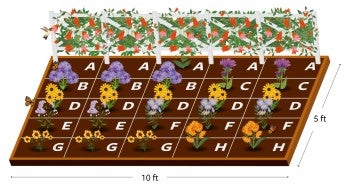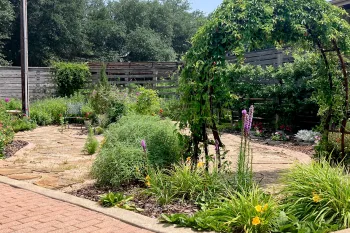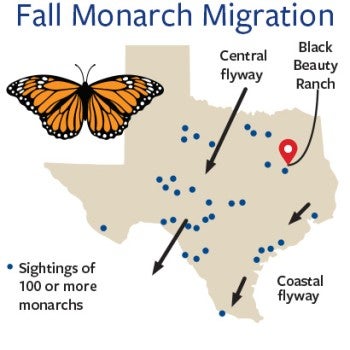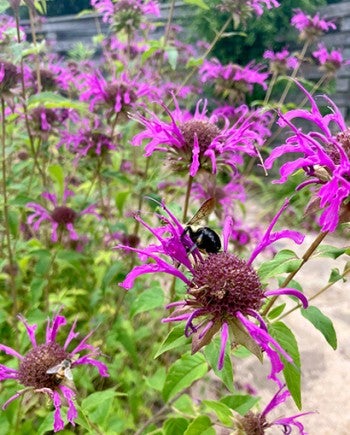Nestled among honking geese, hooting primates, scurrying lizards and lowing cows, the Black Beauty Ranch pollinator garden is “a different kind of place,” says Master Gardener and volunteer Cynthia Holifield. Before Holifield began her work seven years ago, staff despaired of the barren space behind the sanctuary’s welcome center. Now, it’s “just heaven,” says Master Gardener Barb Whitfill, who began volunteering about a year ago.
Holifield and Whitfill have transformed the 2,000-square-foot garden. They’ve trained apple trees to grow against a fence—creating visual structure and providing animal snacks—and registered the garden as a Monarch Waystation that supports butterfly migration. They love discovering new native plants to feed pollinators, such as blue mistflower, which continues to bloom late into the fall after other plants have died back.
Meredith Lee/Humane World for Animals
Create a haven for wildlife
A humane backyard is a natural habitat offering wildlife plenty of food, water and cover, plus a safe place to live free from pesticides, chemicals, free-roaming pets, inhumane practices and other threats. And it's so easy to build!
What’s on the ‘menu’ at Black Beauty Ranch
Fall or spring is the best time to plant these North American native (plants that naturally belong to a specific area) perennials (plants that die back and regrow each year). Choose a hot, sunny spot, and water plants well during their first season in your garden. Afterward, they’ll need very little care and will naturally multiply or spread each year. In a few years, you’ll be able to gift spare plants to other gardeners or move them to other garden beds. (Questions? Email me!)


A. 1 Crossvine ‘Tangerine Beauty’ (Bignonia capreolata)
Evergreen and spring blooming, crossvine grows fast and attracts hummingbirds.

B. 3 Garden Phlox (Phlox paniculata)
Phlox has show-stopping flower clusters beloved by pollinators in summer.

C. 2 Bee Balm ‘Peter’s Purple’ (Monarda fistulosa hybrid)
Bee balm flowers look like fireworks, but the real treat is when goldfinches flock to the seed heads in the fall.

D. 5 Black-Eyed Susan ‘Goldsturm’ (Rudbeckia fulgida var. sullivantii)
These bright yellow flowers last for weeks and attract birds and butterflies.

E. 2 Blue Mistflower (Conoclinium coelestinum)
This dreamy flower spreads quickly and blooms for a long time. Butterflies love it.

F. 3 Aromatic Aster (Aster oblongifolius)
Aster has small blue-purple flowers that provide important late-season food for native bees.

G. 3 Tickseed ‘Uptick Yellow & Red’ (Coreopsis hybrid)
All types of coreopsis produce seeds that birds enjoy eating during the winter.

H. 2 Butterfly Weed (a.k.a. orange milkweed) (Asclepias tuberosa)
This bushy milkweed with bright orange flowers is a food source for monarch butterfly caterpillars, who can only eat milkweed leaves.



